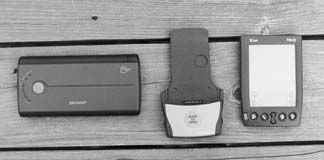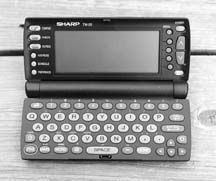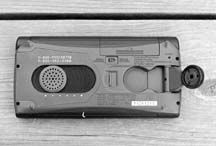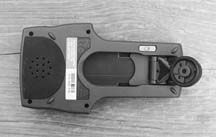Sailors want email on their boats. Walking around the marina in the spring and fall with skippers busily getting their boats ready for their big trips, the conversations invariably drift back to finding ways for staying in touch with families, friends, and businesses.

Email is everywhere. The latest statistics we have seen show that more than 80 million people in the US now have email capability. It is now a fact that email is a “standard” way to communicate in the world today.
Obviously, one of the difficulties with having email capabilities on our boats is the lack of a wire to connect us to the predominantly land-based Internet Service Providers (ISPs). Some wireless systems do exist, but the system and usage costs are generally high enough to discourage all but the most demanding email users.
For about a year now, we have been hearing about a different way to communicate via email. Instead of wireless, it uses land-based wires. Instead of a bulky laptop computer, it can almost fit into a pocket. It can work from almost anywhere on the planet. Finally, the system and usage costs are reasonable so that most people can include it on their provisioning list.
PocketMail System
To address the problem of sending and receiving emails while traveling, PocketScience developed in 1998 an email system to fulfill the needs of travelers. The PocketScience system, called PocketMail, relies on the use of the public telephone system. The system they developed involves a small Personal Digital Assistant (PDA), an acoustic coupler, and an email server available through the public telephone system.
Back in the old days of computers, acoustic modems were the predominant method used to connect to “time-shared” computers. At that time, everyone used Western Electric phones with their standard handset shapes. You simply dialed into a computer service, waited for a tone, and then quickly pushed the telephone handset into two black rubber cups on your Teletype or terminal. The computer and terminal communicated with what sounded like whistle sounds. In those days, it was extremely important to make sure outside noises did not interfere with the computer tones; for example, one day we tracked down a communication problem to a squeaky chair.
Many PDAs (e.g., Palm, Wizard, etc.) and portable computers have modems available. To use these systems, you need to find either a phone jack, open a wall jack and directly connect to the wires, or cobble together a system to connect US-style phone plugs to other country standards. Some modems also come with acoustic couplers with one section that you strap over a telephone handset earpiece and another over the mouthpiece. Because not every traveler has access such as this, the PocketMail system took a slightly different tack.

The PocketMail system uses an acoustic modem for its communications. To overcome the problems associated with the old-style acoustic modems, different style handsets, and differing world standards on acoustic modem communications, PocketScience created a new patent-pending acoustic coupler. With this system, there is no longer a cradle to put the handset into. Instead, the acoustic coupler is one complete unit: there is a pop-out “arm” that covers the earpiece speaker and a speaker that goes near the handset’s mouthpiece microphone. The system filters out most external noise and fits every telephone we tried.
The other part of the PocketMail system is the email server. To send or receive email, you dial into the PocketMail server, hold the PDA up to the handset, and press a start button on the PDA. In a matter of seconds (or a little longer, depending on message size), the communications are finished and your PDA has your received emails. In the US, you dial into the server with a toll-free call (800/POCKETM or 800/762-5386). Outside of the US, you will be charged for the call (local rates apply) and the number you dial is 408/367-7070.
Click here to view the PocketMail Value Guide.
In addition to email, the PocketMail system sends (but does not receive) faxes. Fax messages are sent as clear text, i.e., no formatting or pictures allowed. The next time you dial into the PocketMail server, you will receive the delivery status of your fax messages.
The cost for the PocketMail system is very reasonable. A PDA costs approximately $100. For $9.95 per month, with no commitments past the one month, you get unlimited sending and receiving of emails. Faxes cost an additional 25¢ each in the US and $1 each outside of the US. Email messages are limited to 4,000 or 6,000 characters (dependent on PDA). In addition, PocketMail converts all text and html attachments to text. Other attachments are not converted, but are available to you through a PC.
There are at present three different PocketMail PDA systems: the Sharp TM-20, the JVC HC-E100, and the BackFlip. Because the Sharp and JVC communicate similarly with PocketMail, we decided to test just the Sharp TM-20 and the BackFlip. The Sharp, like the JVC, is a stand-alone PDA, with address book, text entry, and a PC interface. It also has a small keyboard for typing. The BackFlip is quite different. It is an acoustic coupler adapter for the Palm system. You run the PocketMail software on a Palm device, plug the Palm into the acoustic adapter, and then send and receive emails.
The PocketMail communication speeds are very acceptable for something of this low cost. The PocketMail system averages a transfer rate of 60 characters/second (10 words/second). The initial modem training (the whistling tones you hear), occurs in a second or two. Once the PocketMail session is completed, the emails arrived within two minutes at our test locations on desktop computers. Fax messages also arrived in that same time period.
Dealing with PocketMail support is spotty. Many times it took us 15 minutes to get through on the telephone to customer support. Sending emails to customer support, through the PocketMail server, took 48 hours to get a response.
Sharp TM-20
The Sharp TM-20 ($109.95), available at office supply stores, has the PocketMail system built into it. For the purposes of our tests, we were not as concerned about the PDA interface and features as we were with sending and receiving emails.

The TM-20 has a small QWERTY keyboard with some special keys for accessing special symbols. The keyboard is surprisingly easy to use (but not as easy as a laptop’s keyboard). One nice feature is a separate “commercial at” (@) symbol key. We did find some confusion with a few of the keys: differences between the DONE and ENTER keys; Esc key being a wrap-around arrow; the Del key acts like a Backspace key; and unlabeled shift functions.
The TM-20 has a flip-up lid with an LCD screen that has good viewing angle. The unit is 6-3/8″ x 3-1/8″ x 1″. It weighs 8.5 oz., including the two AA alkaline batteries. According to the manual, batteries should last for between 70 and 150 hours, depending on usage, backlighting, etc. The TM-20 turns itself off in

approximately six minutes. It does not come back up where you left off when you press the power switch. The battery compartment door has a nice locking feature that provides an orange dot visual cue that the door is unlocked. Another nice feature is the PocketMail phone number molded into the rubber non-skid that goes over the mouthpiece. However, the 408 number is not on the TM-20, which means that dialing from outside the US will require carrying the phone number or writing it on the TM-20.
On the top of the lid are a series of LEDs and a blue button. On the bottom of the unit are a nifty retractable microphone and a speaker that slides side-to-side. Before you place a call, you must adjust the speaker to match the TM-20 to the telephone handset.
The procedure to connect to PocketMail is very simple. After composing any emails or faxes you want to send (you must press Done after each message to save it), close the TM-20. At a telephone, dial into the PocketMail server, wait for a voice to come on the line, hold the TM-20 up to the phone handset with the microphone completely covering the earpiece speaker, and press the blue button on the top of the unit. The LEDs indicate the progress of the communications. When the communications complete, the “Finish” LED comes on and the unit beeps to alert you. Lastly, replace the telephone handset and check the contents of your in-box on the TM-20.
One drawback to the TM-20 is its inability to work with digital cellular phones. However, the TM-20 is supposed to work with analog cellular phones. We were not able to test this, but talking with PocketMail technical support, some analog cell phones will also have problems with the TM-20.
With some digital phones, it is possible to change the phone from digital to analog. For example, on our Nokia 6120, you would find the switch under Settings/Network Services. We tried this on two different digital cellular phones: the Nokia 6120 and the Nokia 5120. The 5120 worked well in analog mode. The 6120 could not establish communications with the PocketMail server. In our opinion, the radiated EMI from the 6120 gets coupled in with the TM-20 circuitry and creates serious interference in the modem (e.g., you can hear lots of static coming out of the TM-20 as it gets closer to the 6120).
BackFlip
The PocketMail BackFlip ($99, available from PocketMail) works in conjunction with the Palm organizers from Palm, Inc. At present, the BackFlip works with the Palm Professional, Palm III, Palm IIIx, Palm IIIe, Palm IIIc, Palm V, Palm Vx, and Palm VII. For our testing we used a Palm III.

The BackFlip is a cradle that the Palm organizer plugs into. The Palm slides into the BackFlip so that the contacts at the base of the Palm connect with the connector in the BackFlip. When you correctly insert the Palm, two catches lock the Palm into the BackFlip. Because the catches only anchor the bottom of the Palm, the Palm wobbles on the top and can break free from the BackFlip.
There is a mechanical interference problem with some Palm organizers. For example, with our Palm III test unit, the Palm’s plastic cover catches on the BackFlip. The BackFlip’s battery door catches the outside edges at the bottom of the cover by 1/16″. This interference prevented us from fully closing the Palm III cover. You can cure this problem by one of three ways: Remove a small amount of the battery cover on the BackFlip with an X-Acto knife; remove the corners from the Palm cover with an X-Acto knife; or totally remove the Palm cover. If you normally carry your Palm organizer in a modified billfold, you will need to remove the Palm to connect it to the BackFlip.
The BackFlip contains two AAA batteries under a cover on the front of the unit. These batteries are the same size as the batteries in the Palm, so you will only need to carry one kind of batteries for the two devices. The battery cover does not have the locking feature of the Sharp and it is easy to bump off. We did not check battery life, but the literature says that a set of batteries should last: “Approximately four weeks under moderate use with two, AA (sic) alkaline batteries.” To us, this specification is not quantifiable.
The size of the BackFlip is comparable to the Sharp TM-20. The BackFlip’s dimensions, without the Palm organizer, are 5-5/8″ x 3-1/4″ x 1-1/4″. It weighs 4.1 oz., and together with the Palm III the system weighs 10.7 oz. The BackFlip’s color complements the Palm III. On the back of the BackFlip are both the 800 number and the 408 number—a nice touch.
The BackFlip design supports both analog and digital cellular phones. We tried the BackFlip with our two Nokia test phones in digital mode and they transferred without incident.
In terms of usability, especially in comparison to the Sharp TM-20, we found the BackFlip to be cumbersome to use. For example, there are no status LEDs on the BackFlip to indicate communication progress. If you want to see information during the connection, you need to remove the cover from the Palm unit and position your hand so that you can see the Palm screen while still covering the handset with the Palm device. Another example: Instead of pressing a blue button on the unit’s top to begin communicating, you need to press a small gray button on the bottom of the BackFlip. Again, while trying to cradle the Palm in one hand, view the screen, hold the handset with the other hand, and press the button (only needed to begin communications), it is a wild sight in a telephone booth to an outside observer!
An additional issue with the start button is that it is not recessed. When we put our Palm connected to the BackFlip into our knapsack, we would occasionally hear the modem tones start whenever the gear in the bag shifted position. To prevent this, disconnect the Palm from the BackFlip. We did not experience this problem with the Sharp TM-20.
Probably the biggest issue we had with the BackFlip was composing messages using the stylus and the Palm’s Graffiti alphabet. Although we use the Palm everyday, we still find it easier to write messages using the keyboard instead of the stylus. However, this may just be our personal preference.
We did find one software error with the PocketMail software for the Palm. We tried to send an international fax and the PocketMail software would not allow us to enter an international fax number (too many digits). We reported the problem to PocketMail and, to their credit, they had a fix available on their web site three weeks later.
Conclusion
First, let’s discuss the PocketMail service without taking into account the two different methods. The PocketMail service works, and it works very nicely. With the monthly cost as low as it is, the main reasons for staying out of touch have disappeared. Granted, this system will not work at sea, but since most cruisers are coastal and spend the major portion of their time at an anchorage or within cellular phone range of the shore, the PocketMail system makes a lot of sense. Also, the entry cost to purchase the equipment is not price-prohibitive at around $100.
As to the two units we tested, we favor going with the Sharp TM-20. If you already have a Palm device, you still need to buy the BackFlip to work with PocketMail, which is another piece of gear to carry around. If you have a Palm unit, or even if you do not, the Sharp TM-20 is still another piece of gear to carry around. So, the decision of which one to go with cannot be based on whether or not you have a Palm device.
In the end, the Sharp TM-20 is easier to enter messages in and easier to use with the telephone handset. If you can live without a digital cellular phone capability, then the Sharp TM-20 is the one to use. In our opinion, the only reason to go with the BackFlip is if you need digital cellular phone capability.
Contacts-Palm, Inc., 5470 Great America Pkwy, Santa Clara, CA 95052, 408/326-9000, www.palmpilot.com. PocketScience Inc., 2075 de la Cruz Blvd., Suite 100, Santa Clara, CA 95050; 408/919-7444, www.pocketscience.com. PocketMail, 800/390-5034.







































